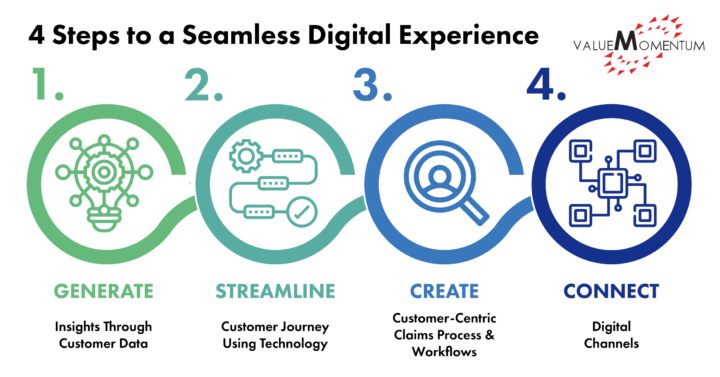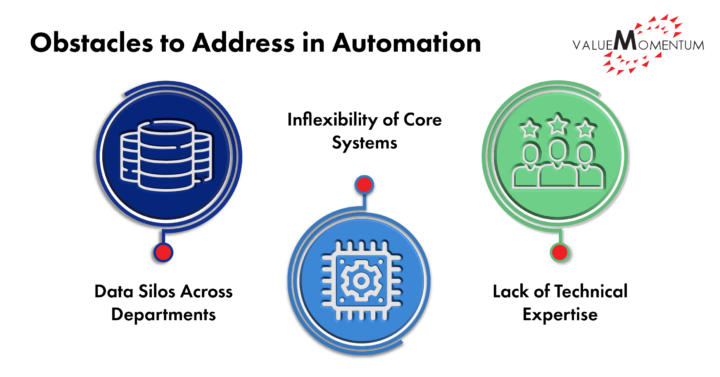
The insurance industry is shifting from one-size-fits-all policies to highly bespoke, personalized solutions. Aligning with this expectation will require insurers to find more ways to analyze customer data and connect each piece of information in real-time to generate meaningful insights.
With the rapid pace of change in customer demands, a seamless insurance digital experience is no longer a feature that differentiates a business; it’s a must-have. When you set out to optimize your insurance customers’ journeys, consider the following four strategies to enhance the digital experience:
1: Generate Insights Through Customer Data
Given the always-on nature of today’s consumer and the rise of digital touchpoints, user-generated information only continues to grow, giving insurers access to a wider range of insights. Just some of the powerful applications of customer data throughout the end-to-end policy life cycle include:
- Creating targeted acquisition and retention campaigns tailored to the individual consumer
- Leveraging behavioral data to better predict what will draw a strong response from customers in the future, such as personalized product recommendations
- Applying psychographic insights to target consumers based on their interests, likes, and dislikes to better understand which channels and messaging they will prefer
As customer expectations for a best-in-class user experience grow, many insurers are struggling to keep pace. As J.D. Power reported, despite industry-wide investments in new technology, overall customer satisfaction with digital offerings failed to improve in 2021.
Although every insurer faces its own unique challenges when it comes to establishing a seamless insurance digital experience, many are coming up against the same problem: an inability to manage and analyze real-time data quickly and effectively.
For many companies, collecting data is the easy part. Deriving value from customer information that can be applied to business growth — like the creation of new business lines or models — has proven to be far more difficult. Organizational challenges, such as a lack of in-house experience, existing siloes, or gaps within legacy systems, have left many companies struggling to generate meaningful returns using data.
In order to remain competitive and begin leveraging customer information to its fullest potential, insurers will first need to establish a modern data platform. By implementing a cloud-native data architecture, your insurance company can accelerate the development-to-deployment cycle, saving time and operational overhead — all while increasing access to data and data analytics tools to derive insights.
2: Streamline the Insurance Customer Journey Using Technology
Emerging technologies, like artificial intelligence (AI), automation, and machine learning (ML), play a key role in helping insurers elevate the digital customer experience while also improving operational efficiencies.
In the insurance industry, highly time-consuming manual tasks are still commonplace, which means that introducing more automated processes can drive significant returns. As both businesses and consumers continue to generate more data than ever before, insurers can leverage AI and ML to refine risk profiles, improve their ability to make predictions, and drive better pricing decisions.
Automation can have a significant impact on the insurance end-to-end customer experience when it is implemented strategically. Achieving the full potential return on the technology investments requires addressing the following obstacles:
Data Silos Across Departments
If data is inaccessible because it is sectioned off across separate business units, the full advantages of automation may not be realized. However, by establishing a single cohesive data platform, ML-enabled algorithms can handle a wider range of tasks than any individual person, from flagging potential user interface (UI) issues to providing more engaging customer interactions.
Inflexibility of Core Systems
One of automation’s key benefits is improving speed to market, allowing organizations to develop and deploy quality products quickly to meet market demands. However, many organizations are still struggling with the technical limitations of legacy systems.
Lack of Technical Expertise
Many organizations lack the internal expertise and/or resources to undertake the implementation necessary to achieve automation. Instead of allowing that to hold them back, they should find a vendor partner or an experienced service integrator to help them through the process.

As insurers seek to capitalize on these emerging technologies to remain competitive in today’s consumer-driven market, it’s important to remember that adopting automation is only one step toward supporting organizational growth. Insurance companies across the industry will need to learn how to leverage advanced technologies to increase customer value, such as building an ecosystem business model to incorporate third-party products and solutions, as well as collaboration with segment-focused distribution partners.
3: Create a Customer-Centric Claims Process and Other Workflows
Any time an insurer considers rolling out a new product or a change in procedure, the customer should be at the heart of the decision. Integrating technology at every touchpoint — from marketing to sales, underwriting, claims processing, and customer service — empowers your team and delivers a faster, more efficient, and overall enhanced experience to your customers.
One example of a popular customer-centric update that many insurers adopted over the past few years, particularly when the need arose for it during the pandemic, is touchless claims processing. The claim processing proceeds from the first notice of loss (FNOL) all the way through the final stages of settlement without ever involving manual intervention. The touchless process ensures customers are informed at each stage of their claim journey and can easily access critical information whenever needed.
Although the benefits of reimagining existing processes through a more customer-centric lens are clear, insurers still must confront several challenges. It’s not a simple undertaking to improve the traditional claims experience, as it requires insurers to evaluate many areas of the organization, including the existing technology environment, processes, and how the organization views claims. However, by addressing these three areas, your organization can begin to implement changes that will improve the overall customer experience.
4: Connect Digital Channels
The ultimate goal when developing a seamless digital experience for consumers is to obtain a 360-degree view of the customer. That would include not just transaction history but mobile activity and social media engagement that together would comprise a holistic view of the customer’s digital experience.
This more comprehensive approach enables insurers to build a more customized experience for the customer. It also empowers internal teams to leverage predictive analytics to inform decisions such as product development and marketing campaigns.
At every stage of the customer life cycle, having a 360-degree view can help insurers to be more proactive and to create more personalized experiences for the customer. Some examples include:
- Identifying prospects: Once a prospect is identified, insurers can use social listening tools to build a living profile of the potential customer, including the persona they align most closely with and the products they may consider relevant. These can be used to shape buyer personas and utilized for targeted marketing.
- Acquisition: A holistic, 360-degree view not only helps insurers establish a clear understanding of risk but also when to move a consumer down the funnel as a response to certain life events or key moments in the customer journey.
- Retention and expansion: Maintaining a best-in-class customer experience requires insurers to have a continuous understanding of customers’ evolving needs in order to be proactive in outreach. A customer’s 360-degree view will reveal not only potential points of failure but also frustration where it takes too long for customers to get to the action or information they seek.
A 360-degree view of the customer is invaluable for marketing, particularly when it comes to cross-selling. By curating product recommendations to build on the company-client relationship, it becomes possible to improve retention while also enhancing customer loyalty.
Advanced analytics tools and capabilities can help streamline the cross-selling process by supporting sales agents and automatically identifying products that best align with their existing customers based on clients’ needs, product portfolio, and purchase history. To make all this possible, insurers need to unify their data, creating a single source of truth that allows different departments and lines of business to collaborate and share data freely.
The challenge to achieving that 360-degree view is that silos persist. They can be due not just to different information management protocols and a varied ecosystem of legacy systems but to a lack of communication between different teams within the organization. Without access to a comprehensive view of the customer, many are still operating on what they have in their own department and cannot fully personalize customer communications and ensure that each interaction with an individual is informed by their previous encounters. Likewise, curated product and solution suggestions may not hit the mark if teams don’t have a full understanding of what a customer is looking for.
The future of the Digital Insurance Experience
In the years ahead, offering highly personalized solutions and near-instant customer support will become an expectation across almost every industry. For insurers, it will be essential to have the capability to collect, scrub, organize, and analyze customer data to develop personalized customer experiences. Once that is achieved, insurers will be on the road to inspiring customer loyalty and generating returns on their data investments.
Interested in leveraging data analytics for customer experience but want guidance on how to get started? Check out our data services to learn how we can help you tap into the power of data analytics.
